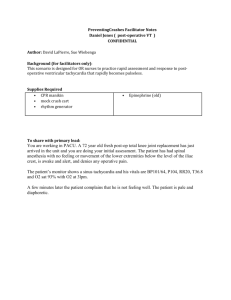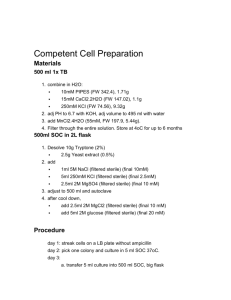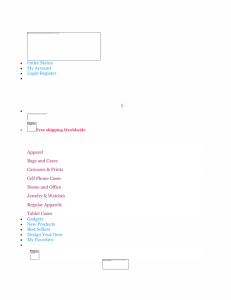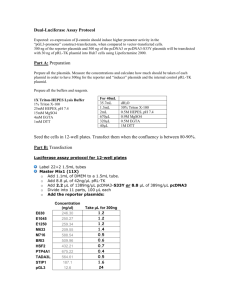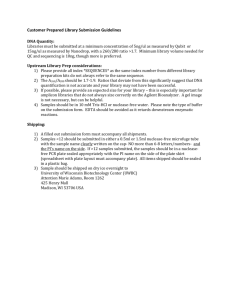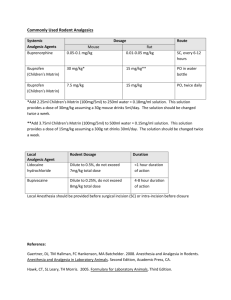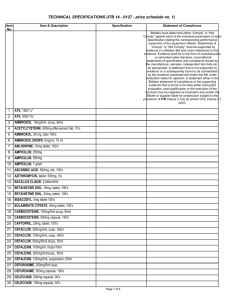Crash cart2 - MidWest Clinicians` Network
advertisement
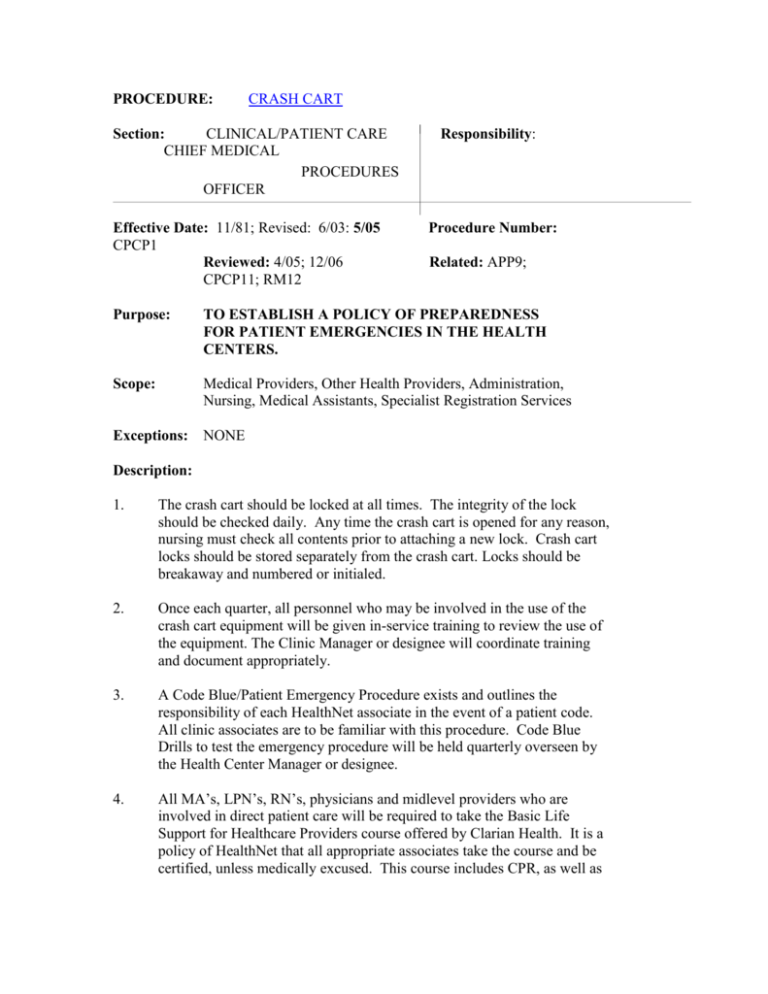
PROCEDURE: CRASH CART Section: CLINICAL/PATIENT CARE CHIEF MEDICAL PROCEDURES OFFICER Effective Date: 11/81; Revised: 6/03: 5/05 CPCP1 Reviewed: 4/05; 12/06 CPCP11; RM12 Responsibility: Procedure Number: Related: APP9; Purpose: TO ESTABLISH A POLICY OF PREPAREDNESS FOR PATIENT EMERGENCIES IN THE HEALTH CENTERS. Scope: Medical Providers, Other Health Providers, Administration, Nursing, Medical Assistants, Specialist Registration Services Exceptions: NONE Description: 1. The crash cart should be locked at all times. The integrity of the lock should be checked daily. Any time the crash cart is opened for any reason, nursing must check all contents prior to attaching a new lock. Crash cart locks should be stored separately from the crash cart. Locks should be breakaway and numbered or initialed. 2. Once each quarter, all personnel who may be involved in the use of the crash cart equipment will be given in-service training to review the use of the equipment. The Clinic Manager or designee will coordinate training and document appropriately. 3. A Code Blue/Patient Emergency Procedure exists and outlines the responsibility of each HealthNet associate in the event of a patient code. All clinic associates are to be familiar with this procedure. Code Blue Drills to test the emergency procedure will be held quarterly overseen by the Health Center Manager or designee. 4. All MA’s, LPN’s, RN’s, physicians and midlevel providers who are involved in direct patient care will be required to take the Basic Life Support for Healthcare Providers course offered by Clarian Health. It is a policy of HealthNet that all appropriate associates take the course and be certified, unless medically excused. This course includes CPR, as well as upper abdominal thrust instruction (formerly Heimlich Maneuver) and other emergency life support procedures. 5. CPR-certified associates will receive training every 2 years as a refresher in emergency life support. 6. All medications will be checked monthly for expiration date. Supplies will be checked (monthly also) to verify they are present and in sufficient quantity. Each center manager will designate a nurse to review the crash cart contents. S/he will note exceptions and ensure that deficiencies are addressed. (See form below.) HealthNet Life Support: Medications and Guidelines for Use Medications How Supplied Typical Indication Warning Adverse Reactions Dose/Route Dextrose D50 Epinephrine 1:1000 Racemic Epinephrine DiphenhydrAMINE 50mg 50 ml bristojet HypoGlycemia assoc. with coma or seizure HyperGlycemia 1ml vial (1mg/ml) Anaphylaxis 2.25% solut. (7.5 ml) Severe croup laryngeal edema 50mg/ml syringe Severe allergic reactions Tachycardia, hypertension Tachycardia Adult: 1 ampule IV 0.01ml/kg per dose 0.05ml/kg per dose nebulized (max 0.5 ml) dilute to 3 ml with Normal Saline subcutaneous (max 0.5ml) Nitroglycerin Sublingual tablet 0.4mg tablet Aspirin Anginal chest pain Possible or confirmed myocardial infarction Sedation, nausea, vomiting Hypotension tachycardia, headache 1-2mg/kg per dose IV or IM (max dose 50 mg) 1 tablet dissolve SL, may repeat Q5 minutes x 3 doses Bleeding, gastric irritation, allergy 1 tablet, chew and swallow 81 mg tablet Quick Reference Dosing Medications Dextrose D50 Epinephrine 1:1000 Racemic Epinephrine DiphenhydrAMINE 50mg Nitroglycerin Sublingual tablet Aspirin 1 ampule IV 0.3-0.5 ml subcutaneous 0.5ml with 2.5ml NS 1ml IV or IM 1 tablet SL 1 tablet 0.1ml 0.5ml with 2.5ml NS 0.5ml with 2.5ml NS 0.4ml IV or IM Adult Pediatric 1yr/old subcutaneous 3yr/old 0.l5ml subcutaneous 0.6ml IV or IM 5yr/old 8yr/old 12yr/old 0.2ml subcutaneous 0.25ml subcutaneous 0.3ml subcutaneous 0.5ml with 2.5ml NS 0.5ml with 2.5ml NS 0.5ml with 2.5ml NS 0.75ml IV or IM 1mlIV or IM 1ml IV or IM CRASH CART CHECK-OFF Instructions: Each center manager will designate a nurse to review crash cart contents every month. The nurse will check the minimum quantity of each item is present and (when applicable) the expiration date has not passed. Exceptions noted should be documented in the third column, plus what was done to fix the problem. Example: Nurse finds only one pocket mask. She should write, “Missing one. Submitted written request to Office Coordinator on 9/1/6 for one pocket mask. “ Nurse will note his/her initials and the check-off date in the last column. Medications 50% Dextrose e.g. Bristojet Nitroglycerin 0.4 mg SL ASA enteric coated 81mg tablet Racemic Epinephrine 2.25% ( 7.5ml) Smelling Salts DiphenhydrAMINE Syringes 50mg/ml DiphenhydrAMINE capsules 25 mg DiphenhydrAMINE syrup 12.5mg/5ml Epinephrine ampules 1:1000 1mg/ml Airways Supplies Masks: Adult Pediatric Infant Nasal Cannula: Adult Pediatric Infant Extension Tubing Ambu: Adult size with mask Pediatric size with peds and infant Mask CPR Mask: Pocket Mask Microshield Oral airways Size 2 Size 3 Size 5 O2 bottles with regulator Suction Euipment: Pediatric Quantity Note Exception/ Action Taken Staff Initials and Date Note Exception/ Action Taken Staff Initials and Date 2 2 1 bottle ( 36 ) 1 2 6 1 bottle 6 Quantity 1 1 1 1 1 1 2 1 1 2 2 2 2 2 1 2 Adult 2 CRASH CART CHECK-OFF IV Supplies Syringes: 3 ml 5 ml 1 ml Bulb Angiocaths: 18 20 22 Arm Boards: Pediatric Adult Buretrol IV Start Kits Test Tubes Red Top Lavendar Top Butterfly 22 G IV Tubing: Microgtt Macrogtt IVF: 1000 ml NS 500 ml NS 250 ml NS Miscellaneous Latex Free Gloves: Medium Low XL Code Form Tape: 1” Quantity Exceptions Noted/ Action Taken Staff Initials and Date Exceptions Note/ Action Taken Staff Initials and Date 2 2 2 2 2 2 2 1 1 1 2 2 2 4 2 2 1 2 2 Quantity 1 box 1 box 1 box 1 2” Coban-3” Scissors Razor Needles 18 g 1 ½” 21 g ¾” 23 g ¾” 1 1 1 3 3 3 CRASH CART CHECK-0FF Miscellaneous 25 g 3/4” 25 g 5/8” Sharp Container Lancets-safety flow Tourniquet-latex free Blood Pressure Cuff Adult Adult Large Child Stethoscope Latex Safe Blood Draw Kit Band-Aids K-Y Jelly Cotton balls 2” Gauze Yankauers Portable Suction Alcohol Pads Code Form Epinephrine Dose Card Quantity 3 3 1 1 1 1 1 1 Assorted 1 tube Assorted Assorted 3 1 1 box 1 1 Exceptions Note/ Action Taken Staff Initials and Date
